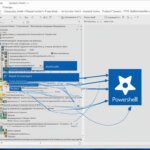Table of Contents
Windows PowerShell is an object-oriented automation engine and scripting language developed by Microsoft. It is a versatile tool that allows IT professionals to automate administrative tasks and manage systems. PowerShell is built on the .NET framework and is available by default on most recent Windows systems. It can be used to automate system tasks, create system management tools, and perform a wide range of activities such as extracting information on operating systems, managing files and folders, and handling network operations.
The Importance of PowerShell in IT Automation
PowerShell plays a crucial role in IT automation. It is a powerful tool for task automation and configuration management in the IT world. With PowerShell, IT professionals can automate repetitive tasks, streamline administrative processes, and manage systems more efficiently.
PowerShell offers a versatile scripting language that allows for precise control and automation of various actions. IT administrators can leverage PowerShell to extract information on operating systems, interact with specialized data stores, and replace the Command Prompt. Its automation capabilities and scalability make it an essential tool for system administrators.
By embracing PowerShell, IT professionals can reduce manual effort, increase productivity, and ensure consistent results across multiple systems. Whether it’s automating server deployments, configuring network devices, or managing virtual machines, PowerShell provides an extensive set of cmdlets and modules that simplifies complex tasks.
Furthermore, PowerShell integrates seamlessly with other Microsoft technologies and platforms, enabling IT professionals to orchestrate workflows, automate server maintenance, and manage cloud resources.
Here’s an example of how PowerShell can simplify a common IT task:
Task: Installing software on multiple computers
Manual approach: IT administrators would have to connect to each computer individually, navigate to the installer file, run the installation, and repeat the process for every machine.
PowerShell approach: IT professionals can write a PowerShell script that installs the software silently on multiple computers simultaneously, saving time and effort.
This level of automation is invaluable in modern IT environments where efficiency and scalability are key.
Benefits of PowerShell in IT Automation:
- Streamlined administrative processes
- Reduced manual effort
- Consistent and reliable system management
- Increased productivity and efficiency
- Automation of complex tasks
- Integration with other Microsoft technologies
With its extensive features and capabilities, PowerShell empowers IT professionals to take control of their automation and configuration management needs.
| PowerShell in IT Automation | Benefits |
|---|---|
| Automate repetitive tasks | Increased efficiency |
| Manage system configurations | Consistent results |
| Seamless integration with other Microsoft technologies | Streamlined workflows |
| Scalability for large-scale environments | Time-saving |
Key Features and Capabilities of PowerShell
PowerShell offers a range of features and capabilities that make it a powerful tool for IT professionals. These features enable users to streamline administrative processes, automate tasks, and efficiently manage systems.
Discoverability
One of the key features of PowerShell is its discoverability. Users can easily find available cmdlets and explore PowerShell’s extensive library of commands. This makes it easier to leverage the power of PowerShell and discover new ways to automate tasks and manage systems.
Help Capabilities
PowerShell provides extensive help capabilities, allowing users to access detailed information and documentation on cmdlets and principles. The built-in help system provides guidance and examples to help users understand the functionality and proper usage of PowerShell commands.
Remote Command Execution
PowerShell has the ability to perform remote commands and operations on multiple computers, making it convenient for managing distributed systems. This capability allows IT professionals to execute commands and scripts on remote machines, providing efficient management and administration of networked environments.
Pipelining
PowerShell supports pipelining, which is a powerful capability for automation scripts. With pipelining, the output of one command can be directly passed as input to another command, allowing for seamless automation and the flow of objects between cmdlets. This feature enhances the efficiency and effectiveness of PowerShell scripts.
Desired State Configuration (DSC)
PowerShell includes a Desired State Configuration (DSC) platform, which allows for specifying and maintaining the desired configuration of servers. With DSC, IT professionals can ensure that servers maintain specific configurations, reducing manual intervention and improving consistency across the infrastructure.
Integrated Scripting Environment (ISE)
PowerShell provides an Integrated Scripting Environment (ISE) for writing and testing scripts. The ISE offers a user-friendly interface with features like syntax highlighting, auto-completion, and debugging capabilities. This integrated environment simplifies the scripting process and aids in the development and testing of PowerShell scripts.
These key features and capabilities of PowerShell empower IT professionals to automate tasks, manage systems efficiently, and enhance productivity.
Using PowerShell for File and Folder Management
PowerShell is a valuable tool for IT professionals when it comes to efficiently managing files and folders. With its extensive range of cmdlets and scripting capabilities, PowerShell empowers users to perform various operations on files and folders, streamlining administrative processes along the way.
One of the key advantages of PowerShell is the availability of dedicated cmdlets specifically designed for file and folder management tasks. For instance, the Get-ChildItem cmdlet allows users to list the files and folders within a directory, providing valuable insights into the file system structure.
With the Test-Path cmdlet, IT professionals can easily determine if a specific file or folder already exists before performing any actions. This avoids potential conflicts or overwriting of important data. Furthermore, PowerShell offers the Copy-Item and Move-Item cmdlets, allowing users to effortlessly copy or move files and folders between directories or locations.
PowerShell also boasts advanced features such as filtering, recursion, and the ability to work with hidden or system files. These capabilities provide IT professionals with the flexibility to target specific files or folders based on criteria like file size, creation date, or file extension. Moreover, PowerShell’s support for recursion enables the processing of subfolders and their contents, facilitating comprehensive file and folder management.
Utilizing PowerShell for file and folder management tasks can greatly simplify administrative processes, reducing manual efforts and minimizing the risk of human error. By automating these tasks, IT professionals can ensure consistent execution and maintain a standardized file management approach.
“PowerShell’s versatility and powerful cmdlets make it an indispensable tool for efficient file and folder management. With its advanced features and automation capabilities, tasks that would otherwise be time-consuming and error-prone can be executed with precision and ease.”
In summary, PowerShell’s robust set of cmdlets and scripting capabilities make it an invaluable asset for IT professionals seeking efficient file and folder management. By leveraging PowerShell, IT professionals can streamline administrative processes, automate repetitive tasks, and achieve greater control and accuracy in managing their file systems.
PowerShell as a Time-Saving Automation Tool
PowerShell is a time-saving tool that can significantly improve productivity and efficiency for IT professionals. By automating tasks with PowerShell, repetitive and time-consuming actions can be transformed into a single command or script.
PowerShell’s scripting logic and object-oriented approach allow for precise and repeatable control over various actions. IT administrators can create scripts for tasks like daily updates, generating reports, cycling services, and more.
PowerShell’s automation capabilities make it an essential tool for managing large networks, performing complex tasks, and maintaining a hybrid cloud environment.
| Benefits of Using PowerShell as an Automation Tool |
|---|
| 1. Increased productivity through task automation |
| 2. Streamlined administrative processes |
| 3. Standardized and repeatable actions |
| 4. Simplified management of large networks |
| 5. Support for complex tasks and hybrid cloud environments |
By leveraging the power of PowerShell’s automation features, IT professionals can save valuable time and eliminate the need for manual, repetitive actions.
Next, let’s explore how IT professionals can learn and master PowerShell to unlock its full potential.

Learning PowerShell for IT Professionals
Learning PowerShell is a valuable skill for IT professionals, particularly those involved in system administration and network management. With its wide range of tools, commands, and modules, PowerShell offers numerous benefits that can simplify day-to-day tasks, enable system-wide changes, and facilitate remote server management.
One of the advantages of learning PowerShell is its ease of use, especially for those already familiar with the Windows Command Prompt. The syntax and command structure are similar, making the transition smoother for IT professionals.
Mastering PowerShell’s scripting logic and understanding its object and variable engine are essential for enhancing skills in this area. By utilizing PowerShell’s command-line and scripting capabilities, IT professionals can create powerful scripts to automate complex tasks and perform system-wide actions.
Various resources and guides are available to help IT professionals learn and explore PowerShell. Online tutorials, official documentation, and community forums provide a wealth of information and support for beginners and advanced users alike.
Learning PowerShell opens up a world of possibilities for IT professionals. From automating routine tasks to managing systems with ease, PowerShell is an invaluable tool in the arsenal of any IT administrator.
By investing time in learning PowerShell, IT professionals can unlock the full potential of this versatile tool and enhance their productivity and efficiency in managing IT infrastructure.
Benefits of Learning PowerShell for IT Professionals
- Automate repetitive tasks and reduce manual effort
- Streamline administrative processes
- Enable system-wide changes with a single command
- Facilitate remote server management
Recommended Resources for Learning PowerShell
- Microsoft Learn: PowerShell – A comprehensive learning platform by Microsoft, offering interactive modules, hands-on exercises, and assessments.
- PowerShell Documentation – The official documentation provided by Microsoft, covering the features, cmdlets, and scripting capabilities of PowerShell.
- PowerShell Community Forums – An active community of PowerShell enthusiasts and experts, providing support, sharing knowledge, and answering queries.
- Online tutorial sites and YouTube channels – Various websites and YouTube channels offer tutorials, tips, and tricks for learning PowerShell, catering to different skill levels.
With these resources at their disposal, IT professionals can embark on a journey to master PowerShell and harness its power for efficient IT automation and management.
Conclusion – Harness the Power of PowerShell for IT Automation
PowerShell is a powerful tool that holds immense potential for IT professionals looking to automate and streamline their workflows. With its extensive range of features, capabilities, and automation possibilities, PowerShell empowers IT administrators to enhance productivity and efficiency in managing systems.
By harnessing PowerShell’s scripting language, cmdlets, and modules, IT professionals can automate repetitive tasks, simplify administrative processes, and achieve more effective system management. With PowerShell, IT automation becomes a reality, bringing tangible benefits to organizations, such as time savings, improved accuracy, and reduced human error.
Investing in learning PowerShell is crucial for IT professionals, as it equips them with the skills and knowledge needed to leverage the full potential of this versatile tool. With PowerShell, IT administrators can unlock the power of scripting and automation in the Windows environment, making their job easier and more efficient.
In conclusion, PowerShell offers IT professionals the opportunity to revolutionize their approach to IT automation. By embracing PowerShell, IT administrators can drive productivity, enhance efficiency, and streamline their systems, ultimately leading to better overall performance and results.
FAQ
What is Windows PowerShell?
Windows PowerShell is an object-oriented automation engine and scripting language developed by Microsoft. It is a versatile tool that allows IT professionals to automate administrative tasks and manage systems.
What is the role of PowerShell in IT automation?
PowerShell plays a crucial role in IT automation. It is a powerful tool for task automation and configuration management in the IT world. With PowerShell, IT professionals can automate repetitive tasks, streamline administrative processes, and manage systems more efficiently.
What are the key features and capabilities of PowerShell?
PowerShell offers a range of features and capabilities that make it a powerful tool for IT professionals. Some key features include discoverability, help capabilities, remote command execution, pipelining, Desired State Configuration (DSC) platform, and Integrated Scripting Environment (ISE).
How can PowerShell be used for file and folder management?
PowerShell provides cmdlets and scripting capabilities for managing files and folders. IT professionals can use PowerShell to list files and folders, check if a file or folder exists, copy and move files and folders, and work with advanced features such as filtering, recursion, and hidden or system files.
How does PowerShell save time for IT professionals?
PowerShell is a time-saving tool that can significantly improve productivity and efficiency for IT professionals. By automating tasks with PowerShell, repetitive and time-consuming actions can be transformed into a single command or script, allowing for precise and repeatable control over various actions.
Why should IT professionals learn PowerShell?
Learning PowerShell can greatly benefit IT professionals, especially those involved in system administration and network management. PowerShell is easy to learn, offers a comprehensive set of tools and commands, and facilitates day-to-day tasks, system-wide changes, and remote server management.
How does PowerShell contribute to IT automation?
PowerShell is a powerful tool for IT automation and management. By leveraging PowerShell’s scripting language, cmdlets, and modules, IT administrators can automate repetitive tasks, streamline administrative processes, and manage systems more effectively.













